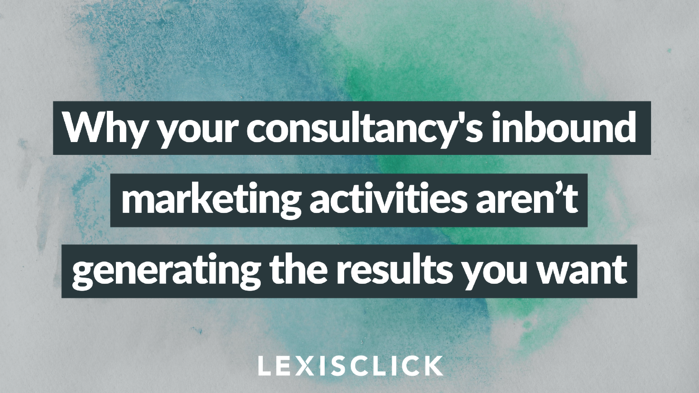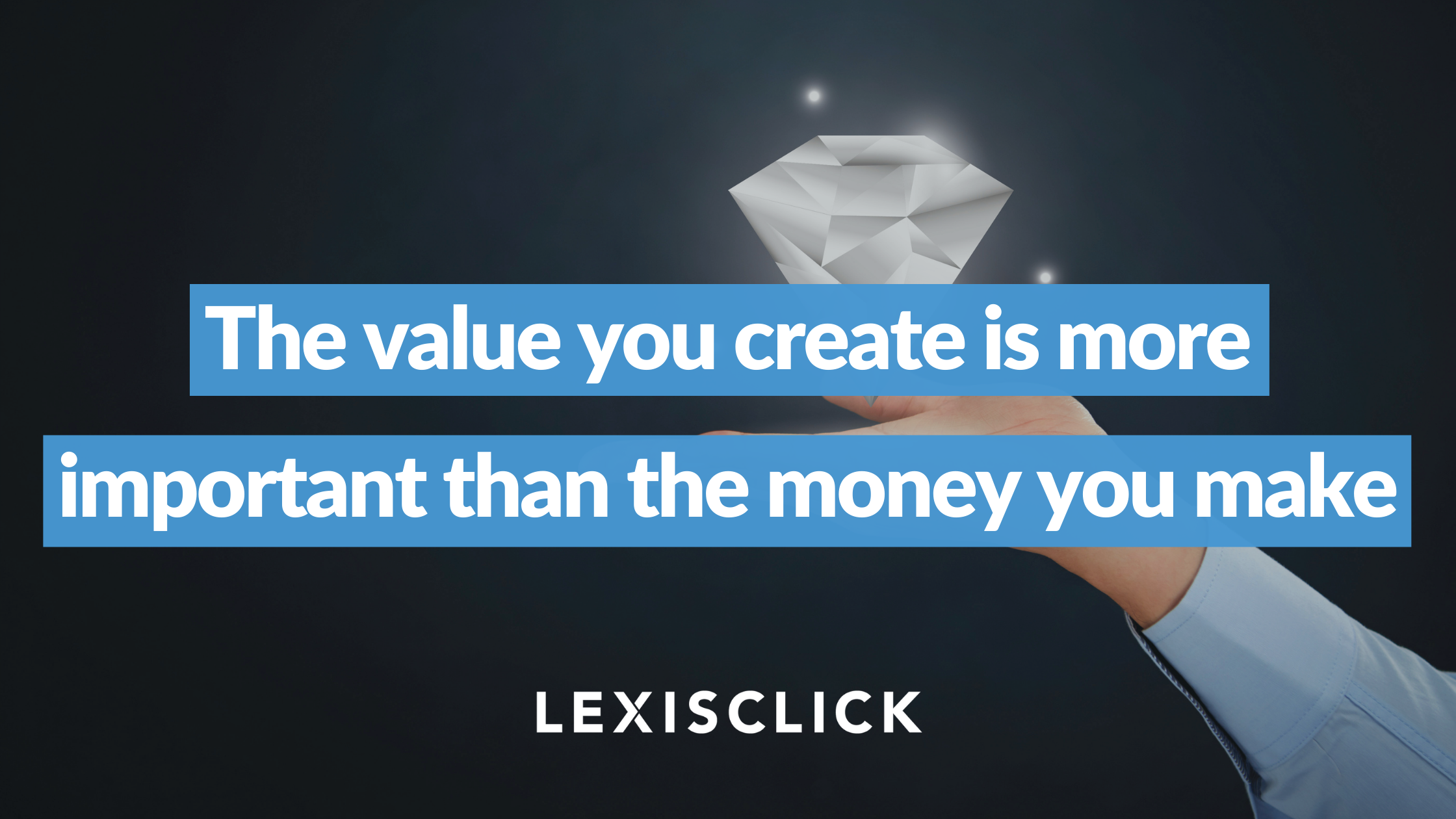
You’ve bought into inbound marketing for your consultancy, you’ve invested in Hubspot or a similar system to deliver it, and now you want the results it promised. The chances are that you’re doing more activities, but those activities aren’t generating the results you’d hoped for.
This post will share some of the critical lessons that I’ve learned from generating over £200 million in growth from the inbound strategies that I’ve implemented for the consultancies and businesses I’ve worked with.
Activities make you busy; they don’t make you rich
-width-700-name-Copy of Copy of Copy of How to set sales pipeline targets for your consultancy (1).png)
There are so many channels available to spread your message and so much advice showing you how you can do it that you could spend every waking hour just trying to keep up.
When you want to follow an inbound marketing approach for your consultancy, you’ll have added lots more to your marketing and sales to-do list. Blogging, social media, video, sales sequences, lead nurturing - the list goes on.
There is one thing for sure; it’ll keep you busy. You’re not reading this to be busier; you’re reading this to get results. And the way to get results is to spend your time building assets.
Too much of the advice out there is focused on activities. That’s why you can find yourself getting busier and busier without a direct connection to results.
Most of us believe that if you work hard, you’ll get results. That’s why we set targets to write more blog posts, post more on social media, make more sales calls and have more meetings.
The trouble with this activity-based approach is that there is a direct link with your time. To get more results, you have to put in more time or spend more money.
It’s even the same with advertising channels like Google AdWords and Facebook Advertising. These channels can generate great results without much time invested, but you need to keep spending more money if you want more results. There’s a direct link between results and money spent.
To get sustainable and profitable results, you need to break the direct link between the money or time you’re investing and the results you’re generating.
Focus on building assets that provide your customers with value
_png_8q4pejnmcch2f6hqp6qqce.png)
When you dig behind all the advice to get busier, you’ll see that every brand and consultancy getting great results is built on assets.
The secret to sustainable results is to build assets that provide your ideal customers with high value.
The good news is that it’s not a significant change to focus on building assets. Nearly every marketing and sales activity can have an asset associated with it or be converted into an asset when done in the right way.
The difference between an activity and an asset is that when you’ve created it, it’ll keep creating value for you because it creates value for your customers. If it stops creating value for your customers, it’ll stop creating value for you.
That’s why the key to creating marketing and sales assets is not to focus on the value they’ll create for you but on the value, they’ll create for your customers. If anything that you create doesn’t provide enough value to your ideal customers, it’ll be much less of an asset for your business.

How to switch from activity-based thinking to assets based thinking
Many traditional measures of marketing and sales inputs focus on activity-based metrics like:
- Website visits
- Blog posts published
- Social media posts
- Sales calls made
- Sales meetings held
Focusing on input-based metrics is important, as you want to make sure that you’re doing enough of the right things to get the results you want. The trouble with these metrics is that they lead you down the path of focusing on activities rather than assets.
You want to change your thinking to focus on the creation of assets. I’m going to use the example of an everyday marketing activity - a blog post.
Activity-based thinking for a blog post
- Target to write one blog post a week
- Promote the blog post three times on social media
- Keep your website up to date
- Keep your customers up to date with what you are doing and selling
- Promote what you are selling
Asset-based thinking for a blog post
- Answer an important question that your ideal customers have
- Determine where the location of the question and post in your customers’ journey
- Identify and optimise the post for search terms they will be using
- Write the post so that it contains several quotes that you can use
- Write the post using a structure and format you can test
- Align the post with a next step your ideal customers can take, based on their likely position in their customer journey
- Write the post to attract ideal prospects and provide value to existing ideal customers
It’s the same activity - a blog post - but approached in two very different ways. I’m sure you can see the benefits that will come from following the asset-based approach. Here are my top 3 benefits of this approach:
- Assets provide more value to your ideal customers
- A similar level of effort creates lasting value
- You can keep improving your assets
Creating assets makes the activities easier
Even with an asset-based approach, there are still plenty of activities to complete in marketing and sales, but they’ll be a lot easier when you’re creating assets. Why? Because you’ve broken the direct link between activity and results.
Using the blog post example above, you can see that all the activities you invest in will strengthen the asset you’ve created, increasing the results that the asset generates for you.
Now that you’ve created your blog post as an asset to provide value to your ideal customers, you’ll be happy to make that improvement when you identify it.
Compare that with a post you’ve created just to hit your activity target of posting once a week. The chances are that you’ll never look at that post again, let alone return to it many times in the future to improve it and promote it further.
That’s a waste because each time you promote a blog post asset you’ve created, you’re increasing the chances that one of your ideal prospects will read it and get value from it. When they do, they’ll be more likely to know, like and trust your brand.
When you create your blog posts as an asset to rank in search engines and use in your lead nurturing and email newsletters. And you align it with your next step call to action and write it to include plenty of quotes that you can share on social media. You create further opportunities to get more value from it.
Also, because the post answers an important question that your ideal prospects and customers have, you’ll keep track of how it performs and identify ways to improve it in the future.
Doing this creates an asset that makes all of your activities easier, an asset that will deliver better and better results over time.
The most valuable brands are the ones that provide the most value to their customers
It’s now no longer enough to say that you’re customer-focused or even customer-centric; your customers expect you to be customer-obsessed.
Many of your customers will know as much about your market as you do, or at least they think they do. They have all the information at their fingertips, and they’re sharing it. They’re sharing how well your product or service works, how good it is and whether it’s good value for money or not.
To thrive in this world, you have to obsess over the value you provide to your customers. It isn’t enough to say that you’re customer focused on your website; you have to deliver for them.
The biggest and most successful businesses in the world, like Amazon, are customer-obsessed. Even though you don’t think they’re competing with you directly as a consultancy, they’re setting your customers’ expectations.
In this customer-obsessed world, it’s essential to deliver value to your ideal customers at every interaction they have with you.
A simple way to ensure you’re doing this is to focus on building marketing and sales assets that provide value to your ideal customers as they move through their customer journey with you.
The value you create is more important than the money you make

Your customers don’t care how much money you are making. They only care about the value that you’re providing to them.
That’s why business objectives to increase sales, revenue, profit, brand awareness, and market share are dangerous metrics to focus on because they’re all self-obsessed. Your customers don’t care about any of those metrics.
Instead, focus on how you can create more value for your customers. When you understand your ideal customers better than anyone else, you’ll understand how you can provide them with more value than anyone else.
The money will follow when you create assets to provide your ideal customers with more value than anyone else. To encourage this approach, set yourself metrics that help you measure and understand the value you are providing to your customers instead of measuring yourself against self-obsessed metrics.
Build a marketing and sales pipeline you are utterly confident with
When you build customer-obsessed marketing and sales assets for your consultancy to provide your ideal customers with value at every touchpoint they have with you; you’ll naturally stand out in your market.
Only the best and genuinely customer-obsessed brands actually deliver on this.
By following this approach, you’ll see that the value that you are creating will attract more ideal customers to your consultancy. The results that you want will flow naturally. The activities will take less effort, and you’ll build a marketing and sales pipeline that gives you complete confidence because your customers love being a part of it.


